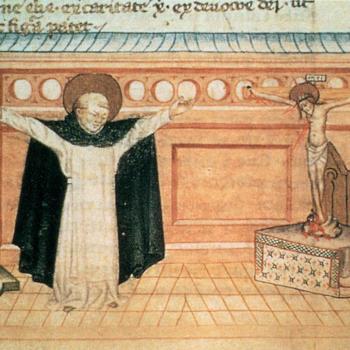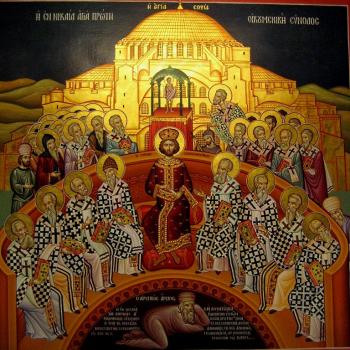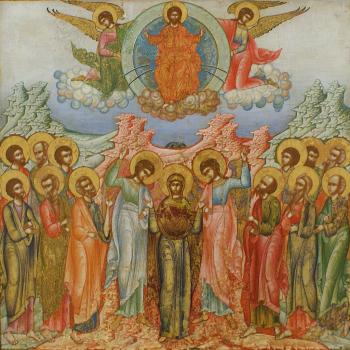
At the transfiguration, Jesus was not changed, but rather, Peter, James, and John were changed, allowing them to see Jesus in a new way. Jesus showed them that underneath the form which they normally saw him, he had other, greater forms of existence, forms which better represent the glory which he, as the Word of God, possesses. In becoming human, the Word of God, the Logos, approached humanity – and the rest of creation – in a form which was easily accessible by all. He meets us where we are at so that he can teach us, telling us what we need to know according to our ability to understand him. That is, as, St, John Chrysostom preached, Jesus skillfully engages us, accommodating himself to our ability and needs:
If he were not willing and ready to accommodate himself, it would be useless to teach sublime doctrines to those who would not listen or turn their attention to them. As it is, even if it were of no benefit to them, yet it did instruct us, it did prepare us to have a suitable conception of him, and it did persuade us that he changed to a more lowly mode of discourse because these people could not yet accept the lofty and sublime things he was saying. Therefore, when you see that he is saying lowly and humble things, do not think this is a mark of any meanness in his essence. See it is an accommodation and condescension on his part because the understanding of his hearers was weak.[1]
St. Hilary of Poitiers agreed:
First of all, we must realize that God did not speak to Himself, but to us, and adapted the words of His discourse to our power of comprehension, so to enable the weakness of our nature to grasp His meaning. [2]
Thus, the kenotic activity of the incarnation, the self-emptying of the Logos in order to become man, represents the way God works with creation. The Logos engages creation on all potemtia; levels of existence so that all in creation can come to know and apprehend God. The Divine Logos, the Word of God, the Son of the Father, is God, but God has come to be with us, God is with us. We know God, not in accordance to the fullness of the divine nature, but in accordance to God’s economic engagement with us. We know God through Jesus, “who, though he was in the form of God, did not count equality with God a thing to be grasped” (Philip. 2:6 RSV), because we, as finite creatures, cannot comprehend God. Thus, we come to Jesus, to God the Word in the form of man. In that form, the Word reveals the divine nature to us, using the image and likeness of God implanted in all humanity as a way to lead us up to God. Nonetheless, we must remember what was shown in the transfiguration: there is more to Jesus than meets the eye; however we come to know him, we must realize there is more left for us to come to know. And if we follow Jesus, then, like Peter, James and John, we can partake of grace and experience Jesus in a way beyond what is revealed solely through his human form.
Even at the transfiguration, what Peter, James, and John experienced was less than the full glory of Christ, for that glory remains the glory of God, a glory which is ever transcendent. The more we experience the divine glory, the more we are drawn into it, and the more we are drawn to it, the more we allow it to transform us to see and perceive more of it in return. Thus, in our eternal theosis, we will find ourselves constantly growing in grace, apprehending more and more of the glory of God, drawing ourselves in deeper and deeper into the glory of God. Since that glory is infinitely transcendent to us, it is a glory which has no end, and so our theosis, and the beatitude which comes from it, likewise is never-ending.
Nonetheless, God draws near to us, allowing us all to approach and engage Jesus in a variety of ways. Different people will experience Jesus differently, but behind all of those different experiences, there remains but one Jesus, one Lord.. And so, St. Cyril of Jerusalem explained:
The Savior comes in various forms to each man for his profit. For to those who lack joy, He becomes a Vine; to those who wish to enter in, He is a Door; for those who must offer prayers, He is a mediating High-Priest. Again, to those in sin He becomes a Sheep, to be sacrificed on their behalf. He becomes “all things to all men” remaining in His own nature what He is. For so remaining, and possessing the truly unchangeable dignity of the Sonship, as the best of physicians and a sympathetic teacher, He adapts Himself to our infirmities. He is Lord in truth, not having advanced to the Lordship, but possessing that dignity by nature. He is called Lord, not improperly as we are, but in the very truth He is Lord, since by the decree of the Father He has Lordship over His own works. [3]
Some, therefore, will encounter Jesus in great glory, but others, thanks to their wayward ways, will encounter him in other, simpler forms. That is, some will experience Jesus more in accordance to his humanity than from his greater glory, so that they will know him more as a man than as Lord, while others will encounter him, still human, but glorified, where his divine glory will be ascertained in and through his humanity. Paul tells us that as Christians, we should seek after the latter; we might first come to know him in a purely human fashion, but if we listen to him and what he has to teach and do as we says, we will find ourselves transformed so that we will no longer know him only in accordance to his humanity. Then, like Paul, we should be able to say: “From now on, therefore, we regard no one from a human point of view; even though we once regarded Christ from a human point of view, we regard him thus no longer” (2 Cor. 5:16 RSV).
We do not all experience Christ the same way. Even Christians experience him differently. Origen said that Paul had an experience of Christ which was greater than his fellow worker, Timothy, but he also said that those who were still caught up in sins will see and experience Christ filtered through such sins:
Then what do I say? Even today the logos is transformed. Paul and Timothy do not see him in the same way. Paul, as opposed to Timothy, sees him glorious, transformed into what is most divine. Timothy sees his glory less fully. When you understand less fully than the latter, you will see a lesser form of Jesus appearing to one who is lesser. But if someone is completely sinful, he completely fails to see his glory, but sees him “not having form or beauty, but his form dishonored, abandoned among the sons of human beings.” They see him a human being, not a human being unbeaten, but “beaten.” If you are beaten, you see him beaten; if you are not beaten, you will not see him beaten. If you are unblemished, you will see him show himself unblemished to you. It is not because he is ever blemished himself or even beaten himself. He bears our infirmities and suffers pain for us, and we reckoned him to be in pain, beaten, and in distress. [4]
It is possible that not everyone will experience Christ in his resurrected glory. St. Albert the Great, following Origen, suggested that as long as someone is a sinner being judged by Christ, his glorified form will not be experienced by them, but rather, they will see and know him accordance to his crucified form:
To the question whether he will judge in a glorious or non-glorious form, we say that it will be in a glorious [form]. But the damned will not see him in a glorious form, but rather in the form in which “they pierced him” – and nevertheless there is no illusion (phantasia] there. [5]
We must encounter the crucified Christ if we are to encounter the resurrected Christ. Inasmuch as we are attached to sin, we experience the damnation of sin, for sin is the cause of its own punishment, but when we detach ourselves from it and cast it upon the crucified Lord, we will then begin to experience him in a new way. The more we cast off our sin, the more we experience Jesus no longer as the crucified Christ come to judge sin, but rather, as the risen Lord who has overcome all sin and shares his grace to all. The glorified form is always there, but our ability to experience it is hindered by our sin. This is not to say, through grace, we cannot and will not have an experience of the glorified Christ, but such visions and experiences will be temporary and also serve for our own spiritual transformation, similar to the way Peter, James and John experienced the transfigured Christ before once again encountering him in a purely human fashion.
The grace we receive in our encounter with Christ, the grace which allows us to see and experience a glorified form of Christ, is meant to change us. Then, not only will we become holy through it, we will become vessels of grace, sharing it with others, so that they too can share in the glory which we have experienced. Just as Jesus emptied himself and revealed himself to all in accordance to their ability to apprehend him, instead of remaining in glory and ignoring the needs of creation, so we, touched by grace, enlightened by grace, experience the glory of God and through it are charged to share that grace with others, helping all of us come together with us in the experience of the divine glory. Thus, the more we have receive, the more we should share with others, proving ourselves proper stewards of grace:
Now to both great and small, Christ apportions to us grace from himself in the same measure, and likewise supplies us all so that we may have life. Moreover, he wishes those who are stronger to gather for others, and to toil on behalf of their brothers, and to bestow upon them the benefit of their labors, and to make them also to become sharers in the heavenly gifts. And this, I believe, is the very thing that was spoken to the holy apostles: “Freely you have received, freely give.” For when these gather much manna for themselves, they are eager to share it with those who live in the same tend, that is, the church. For the divine disciples carried out the task of admonishing the believers, of giving instruction, and leading them into everything that was commendable, ungrudgingly providing for all to participate in the grace which they themselves had received abundantly from Christ. [6]
No matter how we encounter him, Jesus is there, ready to help us, ready to make us like him so that being made like him, we can see him in glory. That is his desire. Even when we encounter him with all our sins, and so see him as the judge who judges all sin, the point is not to condemn the world and destroy it, but to free it from the stain of sin and help all that is within it approach him and receive their own share of the glory of the Lord and so see him face, not merely in the kenotic form which has come to us as man, but as God.
[1] St. John Chrysostom, On the Incomprehensible Nature of God. Trans. Paul W. Harkins (Washington, DC: CUA Press, 1982), 196 [Homily 7].
[2] St. Hilary of Poitiers, The Trinity. Trans. Stephen McKenna, CSSR (New York: Fathers of the Church, Inc., 1954), 309.
[3] St. Cyril of Jerusalem, Procatechesis and Catechesis 1-12. Trans. Leo P. McCauley, SJ and Anthony A Stephenson (Washington, DC: CUA Press, 1969), 198 [Catechesis x].
[4] Origen, Homilies on the Psalms: Codex Monacensis Graecus 314. Trans. Joseph W. Trigg (Washington, DC: CUA Press, 2020), 73 [Homily 2 on Psalm 15].
[5] St. Albert the Great, On Resurrection. Trans. Irven M. Resnick and Franklin T. Harkins (Washington, DC: CUA Press, 2020), 180.
[6] St Cyril of Alexandria, Glaphyra on the Pentateuch. Volume 2: Exodus Through Deuteronomy. Trans. Nicholas P. Lunn (Washington, DC: CUA Press, 2019), 61.
Stay in touch! Like A Little Bit of Nothing on Facebook.
If you liked what you read, please consider sharing it with your friends and family!
















